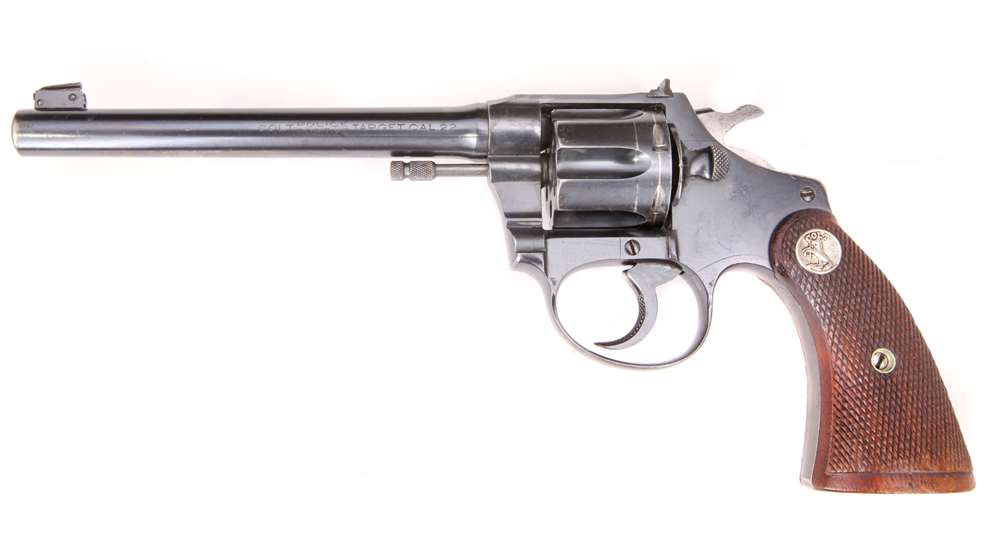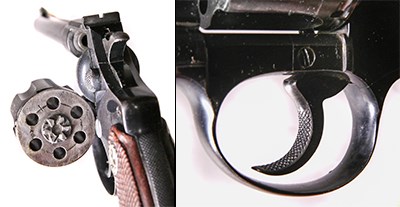
In an effort to outdo Smith & Wesson’s fast-loading, top-break revolvers, Colt brought a solid-frame, swing-out-cylinder revolver to the market in 1889. Its initial models were large-frame handguns in .38 and .41 calibers designed for military use. The success of those models led to Colt’s introduction of smaller-scaled double-actions for the law-enforcement and civilian markets.
The Colt New Pocket, a six-shot revolver offered in various .32-cal. cartridges, was introduced in 1893. Three years later, the New Police was introduced, which married the New Pocket frame with a larger grip for law-enforcement duty. It was promptly adopted by the New York City Police Dept. at the urging of then-police commissioner Theodore Roosevelt.
 The New Pocket was replaced by the Pocket Positive in 1905. This model got its name from the “Positive Lock” mechanism patented by Colt in 1905 that prevented the revolver from firing unless the trigger was pulled. Likewise, the New Police adopted the same mechanism and added the option of .38 New Police or .38 S&W chamberings to become the Police Positive. Along with Colt’s large-frame Official Police, the Police Positive would go on to be a popular law-enforcement sidearm, and just more than 1,000 were supplied to the British during World War II.
The New Pocket was replaced by the Pocket Positive in 1905. This model got its name from the “Positive Lock” mechanism patented by Colt in 1905 that prevented the revolver from firing unless the trigger was pulled. Likewise, the New Police adopted the same mechanism and added the option of .38 New Police or .38 S&W chamberings to become the Police Positive. Along with Colt’s large-frame Official Police, the Police Positive would go on to be a popular law-enforcement sidearm, and just more than 1,000 were supplied to the British during World War II.
As with the New Police, a target version of the Police Positive was made. It featured a 6" barrel and an adjustable rear sight with the topstrap of the frame matted to reduce glare. The trigger and backstrap were checkered. In addition to the .32 cartridges offered in the Police Positive, the Target model was also available chambered in .22 Long Rifle and .22 WRF. In 1923, hard rubber stocks were replaced by checkered walnut, and the cylinder’s chambers were recessed after 1934. A nickel finish was offered on both the standard and target models.
Like the Police Positive, the Target model was made in two versions. The First Issue was made from 1905 through 1925. The Second Issue began in 1926 and had a slightly heavier frame that increased the overall weight of the revolver by about 4 ozs.
The Police Positive Target would serve as a small-frame companion to Colt’s large-frame Officers Model Target. According to Colt’s marketing literature, it was “a fine arm and made to meet the demand for a light, small caliber Target Revolver—medium in price—for both indoor and outdoor shooting; light, smooth pull, well balanced, with the full Colt Grip.” The combination of an affordable price and manageable size meant that the Police Positive Target was more likely to be found on the belt of an outdoorsman than on the competition range. Consequently, many will be found, like the example pictured, with holster wear.
While production of the standard Police Positive would continue until 1947, the last Police Positive Target models were made in 1941. About 28,000 were produced over its production run. The legacy of Colt’s solid-frame, swing-out cylinder, double-action revolvers, like the Police Positive, lives on in the company’s current Anaconda, Python and Cobra models.
The Police Positive Target pictured is a Second Issue model manufactured in late 1930. It is in NRA Good Condition and is valued at $650.
Like the Police Positive, Target models will be encountered with British proofs. Target models in one of the .32-cal. chamberings will bring about a 40 percent premium compared to the rimfire versions.
Gun: Colt Police Positive Target
Manufacturer: Colt’s Mfg. Co.
Chambering: .22 Long Rifle
Manufactured: 1930
Condition: NRA Good (Modern Gun Standards)
Value: $650




































